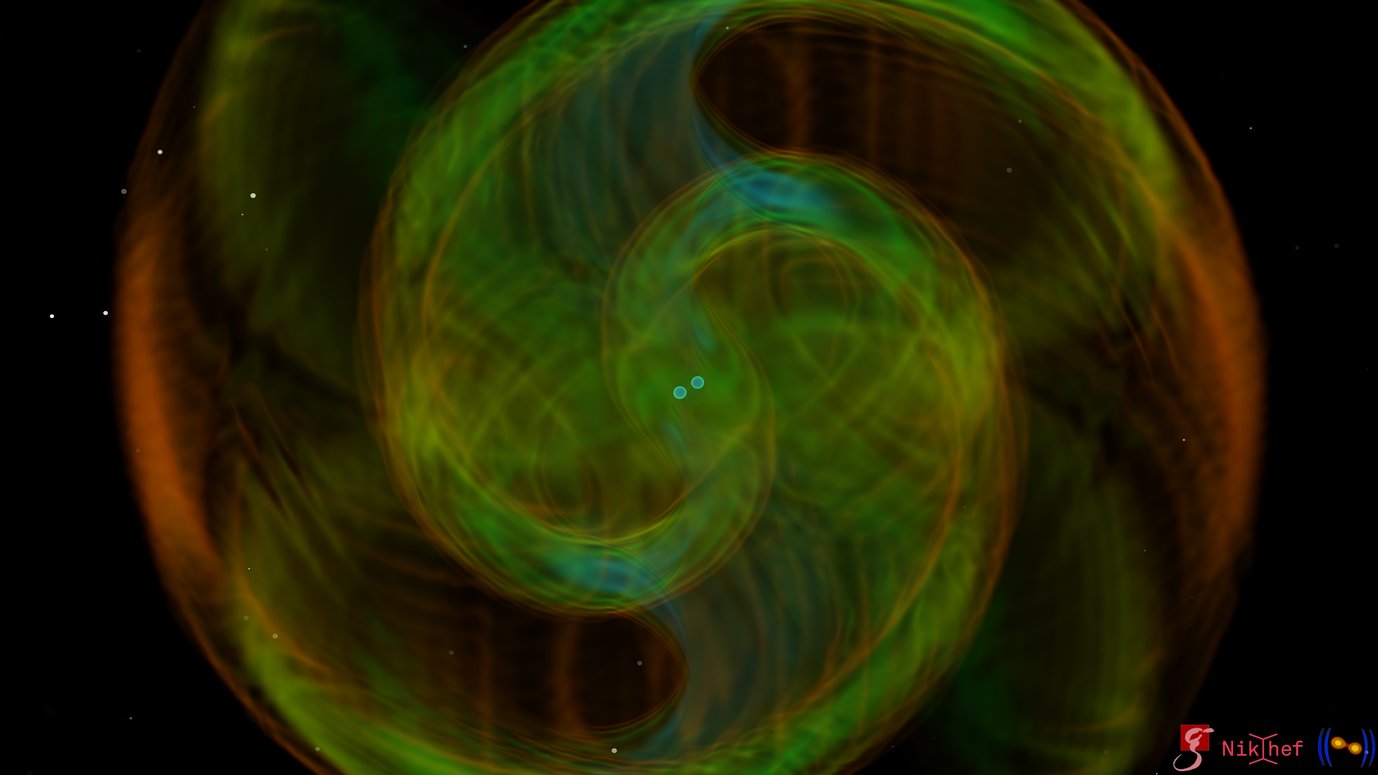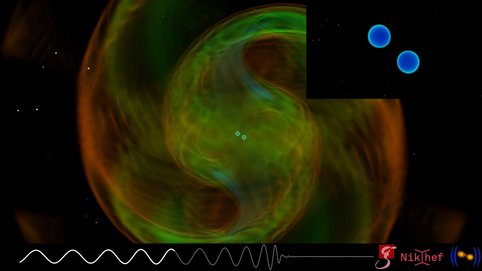News from the Gravitational Universe
LIGO and Virgo observe a distant binary neutron star merger with surprisingly high mass
The international gravitational-wave detector network has observed what is most likely its second signal from merging neutron stars. The signal dubbed GW190425 was identified as a highly significant event by the LIGO Livingston and the Virgo detector on April 25, 2019. The signal comes from a distance of about 520 million light-years, four times farther away than the first gravitational wave from a binary neutron star merger detected in August 2017. No observations by electromagnetic or neutrino observatories related to this signal have been reported. While a binary neutron star merger is the most likely explanation, the combined mass of the system is much higher than that of other known such systems. This could be due to special formation circumstances of the system. It is also possible that one or both objects are light-weight black holes not previously observed.

This discovery was submitted for publication in The Astrophysical Journal and was also just reported in talks by LIGO/Virgo scientists at the 235th Meeting of the American Astronomical Society in Honolulu.
“Binary neutron star mergers are among the most interesting sources for gravitational-wave astronomy,” says Alessandra Buonanno, director at the Max Planck Institute for Gravitational Physics (Albert Einstein Institute; AEI) in Potsdam. “The more such events we observe and analyze, the more we learn about the so far only poorly understood internal structure and composition of neutron stars, and about their mass and how fast they rotate.”
The discovery
At 8:18:05 UTC on April 25, 2019, both the LIGO Livingston detector and the Virgo detector observed the gravitational-wave signal GW190425. The LIGO Hanford detector was temporarily offline at the time. The signal was identified in LIGO Livingston data as a loud signal by a (near-)real-time analysis and was judged to be most likely from a merger of two neutron stars. A follow-up analysis also found the event as a weak signal in Virgo data. The difference in how strong the two detectors observed the gravitational wave comes from their different sensitivity: LIGO Livingston can observe a given binary neutron star merger signal almost three times weaker than Virgo.
The real-time search estimated that such a signal arises from random detector noise about once in 69,000 years, making the probability it being a fluke very low. Further analysis confirmed that GW190425 is a highly significant signal much louder than any other random noise background event.
A public alert including a preliminary sky map was issued within 43 minutes of the event. Since the signal was detected mainly in LIGO Livingston data and only weakly in Virgo data, the sky position was only constrained to about a fifth of the sky (compared to 0.07% of the sky for August 2017 event). Nonetheless, almost 120 follow-up observations by astronomical observatories were conducted. As of today, none of them has identified a counterpart, probably due to the large distance to the source and the uncertain sky position.
Analyzing the waves in detail
Further in-depth analysis of both LIGO Livingston and Virgo data published today, reveals that the signal comes from somewhere in the range from 290 to 740 million light-years, or 2 to 6 times farther away than GW170817 (the first observation of a binary neutron star merger). While the masses of the individual objects are compatible with known neutron star masses, the total mass of the system is between 3.3 and 3.7 solar masses, significantly higher compared to the population of other known binary neutron stars.
AEI researchers have contributed to the methods used to detect and analyze GW190425. They have provided accurate models of the gravitational waves expected from merging neutron stars. Their description included how the neutron stars' structure and composition influence the form of the gravitational waves to in turn obtain information about the source’s properties.
Numerical relativity simulation of the neutron star coalescence GW190425
GW190425’s possible origins
GW190425 was most likely emitted from a pair of high-mass neutron stars, but the gravitational-wave observations alone cannot exclude another explanation: The pair may also have consisted of one or two never-before observed low-mass black holes. These could be primordial black holes, which could have formed in the early Universe, LIGO and Virgo researchers propose as a more exotic explanation.
“GW190425 might be the first observational evidence for a new population of binary neutron stars formed in ultra-tight short-period orbits. While their existence is predicted by some theoretical models, they would be effectively undetectable for radio telescopes searching for pulsars in short orbital period binary systems,” says Frank Ohme, leader of an independent Max Planck Research Group at AEI Hannover.
Alternatively, the system may have formed when in a close stellar encounter a neutron star swapped places with a regular star orbiting a neutron star. LIGO and Virgo researchers provide another possible explanation, which involves gravitational lensing of the signal from a far-away regular-mass neutron star binary.
Update of the merger rate
Assuming that GW190425 is the second gravitational-wave observation of a binary neutron star merger, the scientists can update their estimate of how often these events happen in the Universe: between 250 and 2810 such mergers could happen each year in a cube of the Universe measuring 3.3 billion light-years on each side.
Upgrades of the international detector network
This discovery is the first reported from the third observation run (O3) of the international gravitational-wave detector network. Scientists at the three large detectors (both LIGO sites and Virgo) have made several upgrades to the detector technology.
“The large detectors now all use squeezed light, which was pioneered at the German-British GEO600 detector,” explains Karsten Danzmann, director at the AEI Hannover. “The upgrades also include an increase of the laser power, replacement of the end mirrors, and mitigation of scattered light, all of which resulted in higher detector sensitivities.” These improvements significantly increased the average distance at which the detectors can observe binary neutron star mergers: from 260 to 350 million light-years for LIGO Hanford, from 330 to 430 million light-years for LIGO Livingston, and from 80 to 150 million light-years for Virgo, respectively. Individual signals can be detected at larger distances if they are more favorably oriented towards the detectors.
More than 30 gravitational-wave candidates
The detector network has identified 31 gravitational-wave candidates in the first half of O3 (April 1 to September 30, 2019), the fourth of which is GW190425. While the second half of the observation run has begun on November 1, LIGO and Virgo scientists are examining all candidates and will publish all those for which detailed follow-up analyses confirm their astrophysical origin.
LIGO Scientific and Virgo Collaborations
LIGO is funded by the National Science Foundation (NSF) and operated by Caltech and MIT, which conceived of LIGO and lead the project. Financial support for the Advanced LIGO project was led by the NSF with Germany (Max Planck Society), the U.K. (Science and Technology Facilities Council) and Australia (Australian Research Council-OzGrav) making significant commitments and contributions to the project. Approximately 1,300 scientists from around the world participate in the effort through the LIGO Scientific Collaboration, which includes the GEO Collaboration. A list of additional partners is available at https://my.ligo.org/census.php.
The Virgo Collaboration is currently composed of approximately 480 scientists, engineers, and technicians from about 96 institutes from Belgium, France, Germany, Hungary, Italy, the Netherlands, Poland, and Spain. The European Gravitational Observatory (EGO) hosts the Virgo detector near Pisa in Italy, and is funded by Centre National de la Recherche Scientifique (CNRS) in France, the Istituto Nazionale di Fisica Nucleare (INFN) in Italy, and Nikhef in the Netherlands. A list of the Virgo Collaboration members can be found at http://public.virgo-gw.eu/the-virgo-collaboration/. More information is available on the Virgo website at http://www.virgo-gw.eu.

